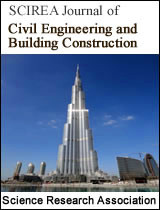Using Experimental and Artificial Intelligence Techniques for Prediction of the Sedimentation at Lateral Intakes
DOI: 10.54647/cebc56057 101 Downloads 12728 Views
Author(s)
Abstract
The main use of the lateral intakes is water conversion from a main channel into a branch channel for different purposes such as water distribution network, irrigation and cooling systems at thermal power plants. The flow structure at the intake is very complicated due to sediment diversions. The intake usually installed making a right angle with the main channel flow direction, it have been noticed that the right-angle intakes produce a large sediment diversion and reduce flow rate inside the intake. Thus, the optimum angle of an intake is very important to minimize sediment volume at the intake channel and to maximize flow rate. Therefore, a physical model utilized to investigate the different obtuse angle of the intake. Five different intake angles (110°, 130°, 145°, 160° and 170°) investigated for the lateral intake with different flow ratios. For further investigation sensitivity and parametric analysis using LSL and ANN-based models applied to experimental results. Analysis of experimental results showed that the intake angle 160° gives better results compared to other intake angles. In addition, the results indicated that the separation zone vanishes at the highest flow discharge ratio at both the intake angle of 160° and 170°.LSL results found that the diverted sediment Svr is most sensitive to the intake angle with 55.3% influence, followed by the discharge ratio with about 40.2% and by the width ratio with about 4.5%. Two ANN-based models were developed using the experimental results combinations from the most influential parameters on the sediment ratio diverted to the lateral intake (Svr) and contraction coefficient (Cc). The ANN models for predicting Svr and Cc performed well with an average R2 of 0.98. The error measures, RMSE shows low values.
From analysis, the optimum lateral intake angle is 164°. Also, the intake angles range 150 to 170 we can neglect effect the width ratios.
Keywords
lateral intake, intake angles, sediment volume, sediment diversion, ANN-based models.
Cite this paper
Ahmed, S.T., M. Soliman,
Using Experimental and Artificial Intelligence Techniques for Prediction of the Sedimentation at Lateral Intakes
, SCIREA Journal of Civil Engineering and Building Construction .
Volume 7, Issue 1, February 2022 | PP. 1-26.
10.54647/cebc56057
References
| [ 1 ] | Afrouz A.,(2015) “Effect Study of Water Intaking Angle Through Flow Regime At Straight Canal”, Larhyss Journal, University of Biskra, Algeria, Vol. 23, pp. 203-211. |
| [ 2 ] | Amin A., Najaf H., Mohammad and Ali P.,( 2014). “The Consequences of Varying The Width Ratio Parameter of The Lateral Water Intake Structure to The Main Canal”, AELIS, India, Vol. 3, pp. 48-54,. |
| [ 3 ] | Pirzadeh B. and Shamloo H.,(2007). “Investigation of Characteristics of Separation Zones in T-Junctions”, 12th WSEAS Int. Conf. on Applied Mathematics, Cairo, Egypt. |
| [ 4 ] | Vanoni A.,(2006). "Sedimentation Engineering: Manuals and Reports on Engineering Practice", ASCE publication, No. 54, New York,. |
| [ 5 ] | Amin A.,(2005). "Study of Sedimentation At River Side Intakes", Thesis , Egypt. |
| [ 6 ] | Neary V.S., Sotiropoulos F. and Odgaard A.J.,(1999)."Three-Dimensional Numerical Model of Lateral-Intake Inflows", Journal of Hydraulic Engineering, ASCE, Vol. 125 pp. 126-140. |
| [ 7 ] | Novak P., Moffat A.I.B., Nalluri C., and Narayanan R.,(1999)."Hydraulic Structures" 4th Edition Handbook, Unwin Hyman, London. |
| [ 8 ] | Neary V. S. and Odgaard A. J.,(1993)."Three-dimensional Flow Structure at Open Channel Diversions", Journal of Hydraulic Engineering, ASCE, pp. 119, No. 11. |
| [ 9 ] | Raudkivi A.J.,(1993). "Sedimentation: Exclusion and Removal of Sediment from Diverted Water", Handbook , Balkema, Netherlands. |
| [ 10 ] | Razvan E.,(1989)."River Intakes and Diversion Dams", Handbook, Elsevier, Amsterdam |
| [ 11 ] | Taylor E.,(1944). "Flow Characteristics at Rectangular Open Channel Junctions", Trans., ASCE, Vol. 109, pp. 893-912. |
| [ 12 ] | Verbeeck, H., Samson, R., Verdonck, F., & Lemeur, R. “Parameter sensitivity and uncertainty of the forest carbon flux model”. FORUG: a Monte Carlo analysis. Tree physiology, 26(6), 807-817, 2006. |
| [ 13 ] | Lei, J. H., & Schilling, W. “Preliminary uncertainty analysis–a prerequisite for assessing the predictive uncertainty of hydrologic models.” Water Science and Technology, 33(2), 79-90. 1996. |
| [ 14 ] | Chen, S., Zheng, Y., Cattani, C., & Wang, W. “Modeling of biological intelligence for SCM system optimization”. Computational and Mathematical Methods in Medicine, 2012. |
| [ 15 ] | Mabel, M. C., & Fernandez, E. “Analysis of wind power generation and prediction using ANN: A case study.” Renewable energy, 33(5), 986-992, 2008. |
| [ 16 ] | Sheikh, S. K., & Unde, M. G. “Short term load forecasting using ANN technique”. International Journal of Engineering Sciences & Emerging Technologies, 1(2), 97-107, 2012. |
| [ 17 ] | Lu, Pengzhen, Shengyong Chen, and Yujun Zheng. "Artificial intelligence in civil engineering." Mathematical Problems in Engineering. 2012. |
| [ 18 ] | Steel, R. G., & Torrie, J. “Principales And Pricedures Of Statistics”. Mcgraw-Hill Book Company, Inc,; New York; Toronto; London, 1960. |
| [ 19 ] | Glantz, S. A., & Slinker, B. K. “Primer of applied regression and analysis of variance” (No. Sirsi) i9780070234079), 1990. |
| [ 20 ] | Legates, D. R., & McCabe, G. J. “Evaluating the use of (goodness of fit) measures in hydrologic and hydroclimatic model validation”. Water resources research, 35(1), 233-24, 1999 |
| [ 21 ] | Witten, I. H., Frank, E., Hall, M. A., & Pal, C. J. “Data Mining: Practical machine learning tools and techniques”. Morgan Kaufmann, 2016. |

